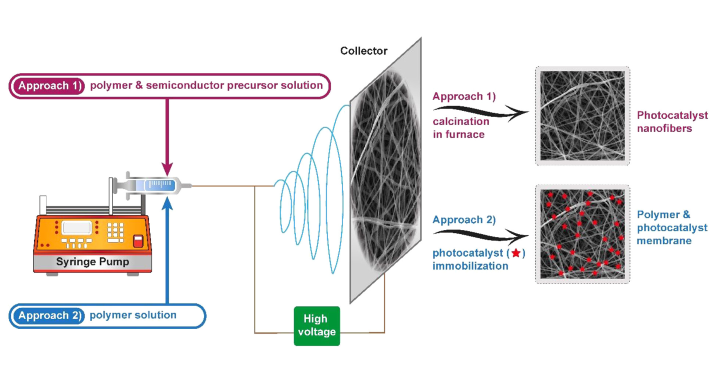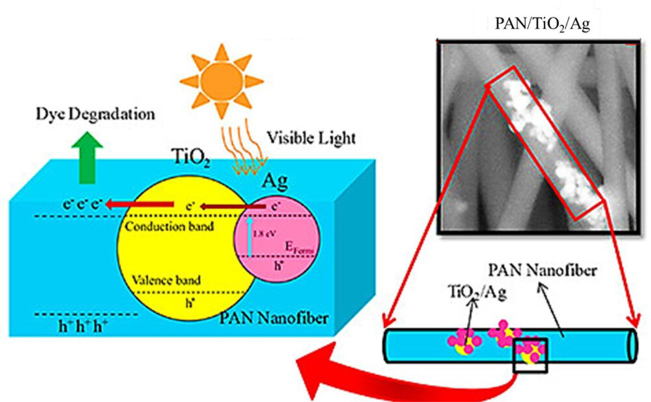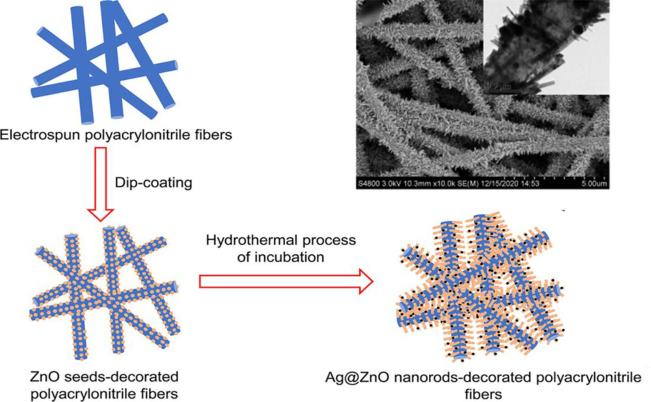Copyright © 2022 Foshan MBRT Nanofiberlabs Technology Co., Ltd All rights reserved.Site Map
1 Application of nanofibers in photocatalysts
Photocatalysts for wastewater purification can be expected to be fabricated using electrospinning, which has the potential for large-scale and industrial production. The advantages of applying photocatalysts for water purification are low cost, environmental protection, reusability, and simplicity. In addition, compared with traditional wastewater treatment methods, no secondary pollution will be generated. Nanofiber photocatalysts are more efficient than nanoparticle analogs in photocatalytic applications. Electrospinning is a simple, versatile, and inexpensive method for fabricating various 1D nanofibers with different applications. The properties of these nanowoven nanofibers make them good candidates for use as membrane filters. In addition, their high surface area enhances the adsorption capacity for the removal of pollutants in wastewater. Different techniques, such as modifying polymer composition, engineering chemical surface structure, and immobilizing active and functionalized species, can enhance the ability of electrospun nanofibrous membranes in wastewater treatment.

Figure 1 Schematic illustration of charge carriers and reactive oxygen species (ROS) generation during photocatalysis.
2 Advantages of electrospinning-based photocatalysis
(1) Compared with the powdery photocatalyst in the slurry system that would agglomerate during continuous utilization, anchoring the photocatalyst on the electrospinning mat can improve its stability.
(2) The independent photocatalyst membrane is used as a floating water treatment system for simple separation, which is convenient for its practical application.
(3) The specific surface area of electrospun nanofibers is large, which promotes the adsorption of organic pollutants and improves the photodegradation efficiency.
(4) The functionalization of different chemical groups on polymer electrospun nanofibers can enhance the adsorption capacity for water treatment.
(5) The one-dimensional photocatalyst nanofibers have long-axis ratio, which can promote fast charge transfer, enhance electron-hole separation, and achieve high-efficiency photocatalytic activity.
3 Strategies of electrospinning to prepare photocatalysts
Based on previously published studies, electrospinning-based photocatalysts can be divided into two categories. Figure 1 shows an overview of these methods. One strategy is to utilize 1D electrospun nanofibers as scratch templates for photocatalyst formation. In this method, polymer electrospun nanofibers are mainly decomposed by annealing, and the semiconductor precursors are transformed into crystalline structures. In another approach, electrospun polymer mats are used to grow and form semiconducting photocatalysts.

Fig. 2 Process overview of the preparation of photocatalyst nanocomposites by electrospinning technique.
In the first method, electrospun polymer nanofibers were used as sacrificial templates to form 1D semiconductor photocatalysts. This approach can provide pure hybrid nanocomposite photocatalysts. The main challenge of this approach is the selection of suitable semiconductor-forming precursors and appropriate annealing temperatures for photocatalyst crystallization and polymer template elimination. Although this method is reliable and versatile for the production of several pure and hybrid photocatalysts, the low productivity of laboratory-scale electrospinning machines encourages the use of multi-nozzle or nozzle-less electrospinning machines to scale up their industrial production.

Fig.3 The degradation mechanism of dyes on PAN/TiO2/Ag nanofibers and their corresponding SEM images
The second method utilizes electrospun polymer nanofibers as a platform for the synthesis of photocatalysts. While the flexibility of electrospun mats is helpful for practical applications, its wrinkling and folding upon exposure to semiconductor growth solutions is a major concern. Furthermore, the polymer is chosen such that it is insoluble in the growth solution. Regarding these challenges, physical methods of depositing photocatalysts are more favorable. Establishing a proper chemical anchor between the photocatalyst and the electrospun membrane should be considered to provide reliable recovery and reusability of the photocatalyst. In addition, photocatalyst leaching into treated water should be tested for proper stability. Furthermore, the chemical stability of polymer nanofibers should be considered during the reaction between charge carriers and/or ROS species and the polymer surface. However, a positive aspect of this approach is that the high porosity of the electrospun polymer mat can provide synergistic adsorption and photocatalytic degradation for efficient wastewater treatment.

Fig.4 Schematic diagram of Ag@ZnO nanorods decorated on PAN film
4 Potential directions for future research
(1) Although the parameters of the electrospinning process have been formulated so far, there are few quantitative studies on the relationship between experimental studies and mathematical parameters, and most of the work is reported qualitatively.
(2) So far, nanofibers with diameters smaller than 50 nm have been produced to generate larger surface areas and improve water purification. Therefore, further studies can be performed by tuning the electrospinning parameters to achieve thinner nanofibers.
(3) At the level of large-scale production, a large amount of evaporated organic solvents enter the environment, making electrospinning not environmentally friendly. To overcome this difficulty, it is suggested to use melt electrospinning or install a solvent recovery system.
(4) The chemical functionalization of electrospun nanofibers can induce chemical bonds between them and photocatalysts, hindering the detachment and unwanted release of photocatalysts.
(5) The use of visible-light active photocatalysts is encouraged due to the use of solar radiation as an inexpensive, abundant, and clean light source. This issue has recently received a lot of attention due to the environmental pollution caused by the heavy use of fossil fuels.
(6) Emerging aquatic pollutants, including personal care products, pharmaceuticals, and endocrine-disrupting chemicals, have entered surface waters through human waste. All these products are of human concern for effective wastewater treatment. Photocatalytic processes can remove some of these, while proving the ineffectiveness of conventional treatments. Therefore, addressing this problem is essential and valuable in addition to removing organic dyes.
(7) The use of nozzleless electrospinning technology can solve the problem of low yield of electrospinning photocatalyst products.
(8) The combination of polymer piezoelectric film and piezoelectric photocatalyst improves charge carrier separation and photodegradation efficiency. Addressing these combined materials could lead to the fabrication of multifunctional membranes for air and water purification.
Reference
[1] Recent Developments of Electrospinning-Based Photocatalysts in Degradation of Organic Pollutants: Principles and Strategies. Morasae Samadi and Alireza Zaker Moshfegh, ACS Omega 2022 7 (50), 45867-45881.
DOI: 10.1021/acsomega.2c05624
Lab scale electrospinning machine: https://www.nanofiberlabs.com/products-category/lab-scale.html
Industrial electrospinning equipment: https://www.nanofiberlabs.com/products-category/production-line.html